Cooking is an art, and everyone who loves cooking wants their cookware to be durable and easy to use for a longer time. When selecting new cookware for the kitchen, whether a pot, pan, tawa, or kadai, most people look for two materials- hard anodized and stainless steel.
Apart from non-stick and cast iron, most cookware brands use stainless steel or hard anodized aluminum to make their pots and pans corrosion-free with high longevity. By using such cookware, you can cook a wide variety of foods.
Some users prefer hard anodized cookware due to its attractive design and non-stick properties, while some choose stainless steel cookware. To find out the worthiest, here we have compared the differences between hard anodized cookware vs stainless steel cookware with their advantages and disadvantages.
What is Hard Anodized Cookware?
Aluminum is the base material of hard anodized cookware. By nature, it has high heat conductivity but is not a healthy choice compared to stainless steel cookware. For this reason, cookware manufacturers like Hawkins and Prestige started anodizing the aluminum utensils to produce the best hard anodized cookware with more safety.
In the anodization process, the aluminum cookware is converted into an attractive, sturdy, rust-resistant hard anodized cookware with an anodic oxide finish. Though the aluminum becomes harder in the process, it remains more lightweight than stainless steel cookware. Most manufacturers apply a non-stick coating on the hard anodized cookware to make it easy to use and clean.
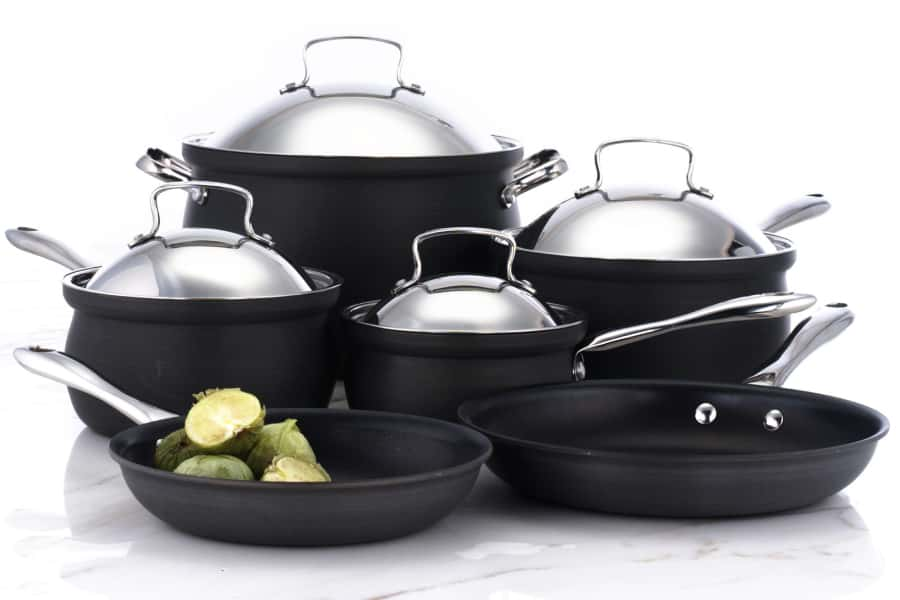
Advantages
Disadvantages
Learn More: Advantages & Disadvantages of Hard Anodized Cookware
What is stainless steel cookware?
Stainless steel is one of the most popular cookware materials for its high durability, versatility, shiny design, and ease of use. It is an alloy of iron combined with chromium, nickel, and other elements.
When the chromium content in stainless steel is exposed to air during the manufacturing process, it reacts with oxygen to form chromium oxide. This semi-inert oxide coating protects the inner material and thus makes stainless steel rust-resistant. It has a shiny white finish which we see in all stainless steel cookware.
Depending upon the material composition, stainless steel is available in several grades. SS 304, SS 316, and SS 430 are the best choices for food-safe stainless steel cookware for daily and occasional uses.
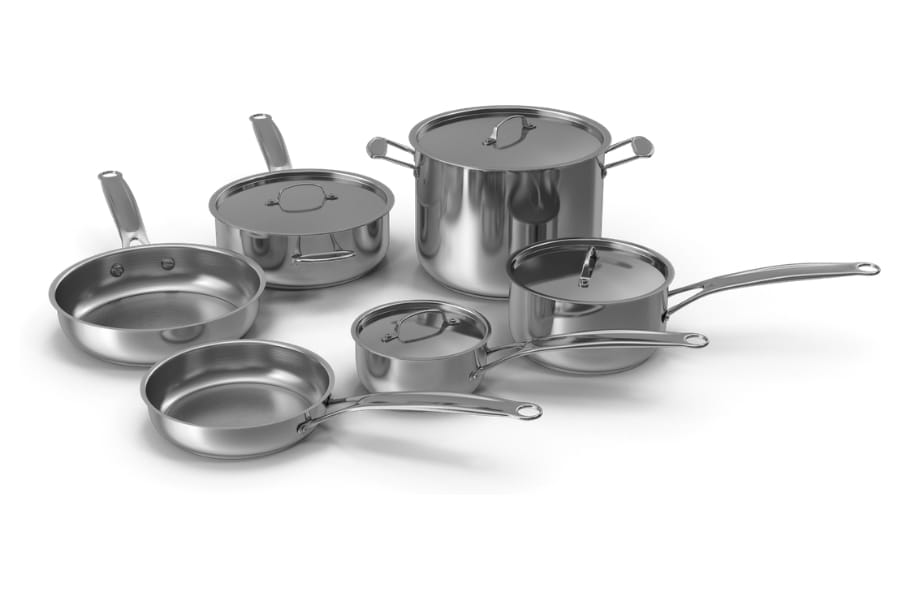
Advantages
Disadvantages
Also Read: Pros And Cons Of Stainless Steel Cookware
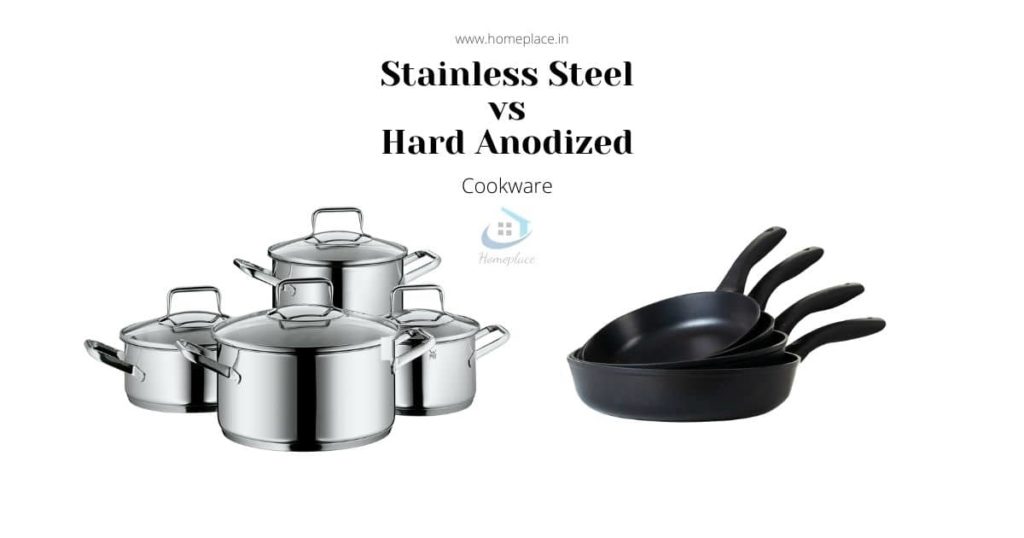
Hard Anodized vs Stainless Steel Cookware – Comparison
| Point Of Difference | Hard Anodized Cookware | Stainless Steel Cookware |
|---|---|---|
| Heat Conductivity | Hard anodized cookware has higher heat conductivity than stainless steel cookware because of the aluminum core. This type of cookware is heated faster and takes less time to cook. | In the case of stainless steel cookware, the heat conductivity is relatively lower than the hard anodized cookware. This type of cookware takes more time to get heated. However, it’s a matter of seconds which can be ignored. |
| Non-Stick Property | Hard anodized cookware is usually manufactured with a non-stick coating. It helps to cook food without sticking to the pan and clean without hassle. | On the other hand, stainless steel cookware does not have a non-stick coating. To avoid food sticking to the pan, you may need to use more oil during cooking or frying. |
| Durability | Hard anodized cookware is less durable than stainless steel cookware as the anodized and non-stick coatings can deteriorate over time. | Stainless steel is the most durable and stain, corrosion, and rust-resistant cookware available in the market. As there is no special coating, it lasts for decades. |
| Cleaning | For cleaning the hard anodized cookware, you have to wash it using a non-abrasive sponge as they are incompatible with dishwashers, and abrasive cleaning tools can damage its surface. | You can easily clean stainless steel cookware in the dishwasher for cleaning besides washing by hand. However, cleaning needs more effort as there is no non-stick coating. |
| Price | Good quality hard anodized cookware sets are priced in the range of ₹1200-₹5000. | Stainless steel cookware sets are priced in the range of ₹800-₹6000, depending on the number of pieces and types of cookware. |
Also Read: Stainless Steel Vs Non-Stick Cookware
Differences Between Hard Anodized And Stainless Steel Cookware
Finding the worthiest from hard anodized vs stainless steel cookware, it is wise to compare them and understand their differences in terms of crucial decision-making factors. These are-
Material
Hard anodized cookware has an aluminum core with an anodized body, often coated with a non-stick layer. This type of material has a high heat conductivity, fast cooking time, and is easy to use.
On the other hand, stainless steel cookware is beneficial for its non-reactive material and is also cleanable in the dishwasher. It does not have a non-stick coating like hard anodized cookware, but it is very cost-effective.
Induction cooktop and gas stove compatibility
Both the stainless steel and hard anodized cookware come with induction and non-induction variants, while all of them can be used on the gas stove. Induction cooktop-compatible cookware often contains SS-430 grade stainless steel at the bottom.
Unlike SS-304 stainless steel, SS-430 is ferromagnetic in nature and induces an electromagnetic field to generate heat and cook food. As the material is costly, induction compatible stainless steel and hard anodized cookware are also priced higher.
Cooking Performance
You can cook almost anything on stainless steel cookware- pots, frying pans, kadai, handi, tawa, etc. It is the ultimate versatile cookware for boiling water, cooking curry, frying pakoda, or making rice. However, as stainless steel cookware does not have a non-stick coating, delicate foods like omelets, fish, and dosa tend to stick to the cookware surface. You can preheat and use a little more oil to avoid this problem.
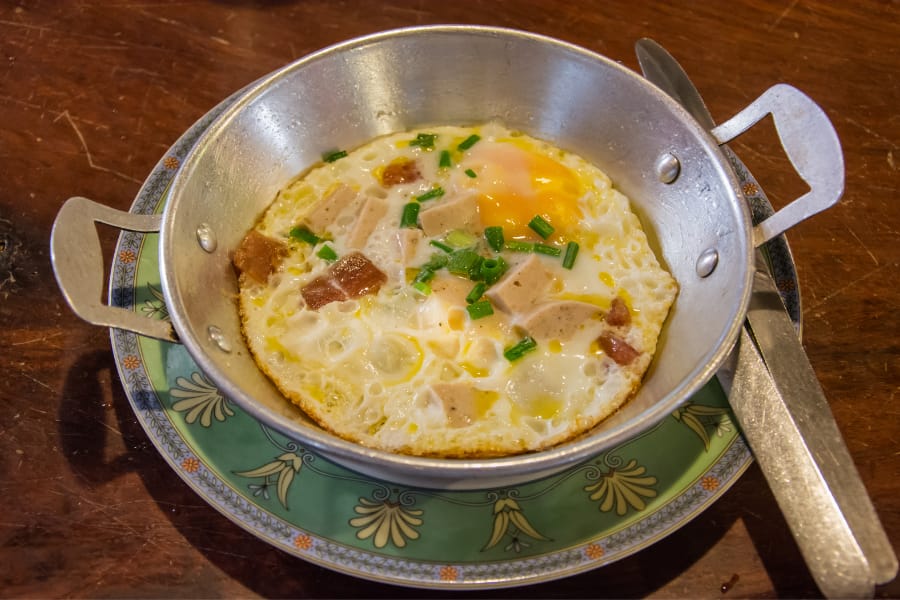
The best thing about stainless steel cookware is that it is perfectly food-safe and does not react with the food. Being non-porous in nature, it does not change your food’s delicious flavor. Also, as stainless steel cookware does not have a Teflon coating, it is free from health risks.
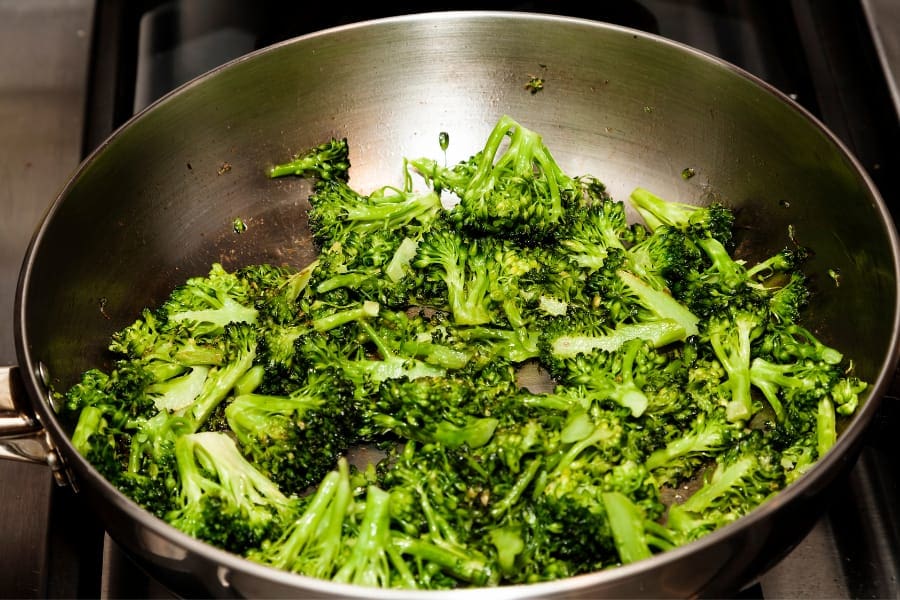
However, as the thermal conductivity of aluminum (237 W/m K) is higher than stainless steel (14.4 W/m K for SS 304), hard anodized cookware heats up much faster than stainless steel cookware. For this reason, frying and browning performances are better done in hard anodized cookware.

Also, due to the presence of non-stick coating, hard anodized cookware does not allow food to stick to the surface and provides a hassle-free cooking experience. It is also easy to wash, though incompatible with a dishwasher for the same reason.
Cleaning and Maintenance
Both the stainless steel and hard anodized cookware have merits and demerits in terms of cleaning and maintenance. Cleaning hard anodized cookware is tricky as it is incompatible with the dishwasher. However, you can easily clean it using a soft sponge and a non-abrasive detergent due to the non-stick surface.
Comparatively, you can clean and maintain stainless steel cookware using both the dishwasher and hands. As it does not have a non-stick coating like hard anodized cookware, most traditional cleaning methods work with it.
Durability and longevity
Stainless steel cookware is more durable than hard anodized cookware as it does not have any additional coating. The anodized and non-stick coating can degrade over time which is not the case with stainless steel. Stainless steel cookware can last for generations with more longevity and durability.
Affordability
While both hard anodized and stainless steel cookware are affordable, the latter usually costs higher. This is because aluminum is cheaper in price, and the only cost that adds up is the cost of the anodized non-stick coating. Though stainless steel cookware is priced slightly higher, it lasts longer than hard anodized cookware.
So, which is better – Hard Anodized or Stainless Steel cookware?
In the comparison of hard anodized cookware vs stainless steel cookware, we have mentioned the advantages and disadvantages of each. Both the hard anodized cookware and stainless steel cookware have their own benefits and drawbacks that make them different.
If you prefer to have cookware with non-stick properties, high heat conductivity, and faster cooking, hard anodized cookware is your best choice.
But, if you want cookware with more food safety, compatibility with high-temperature cooking, and easy to clean in a dishwasher, stainless steel cookware is your way to go.
Therefore, assess the pros and cons of hard anodized and stainless steel cookware, know their differences, and choose the suitable one according to your needs.
Also Read:
